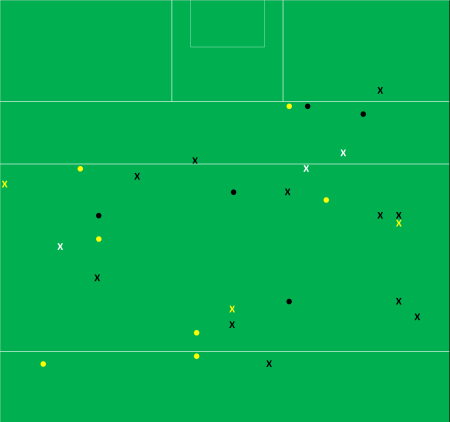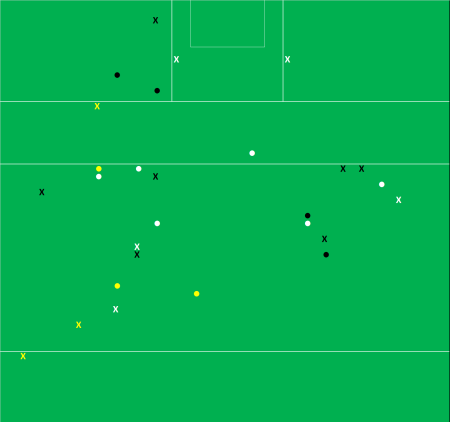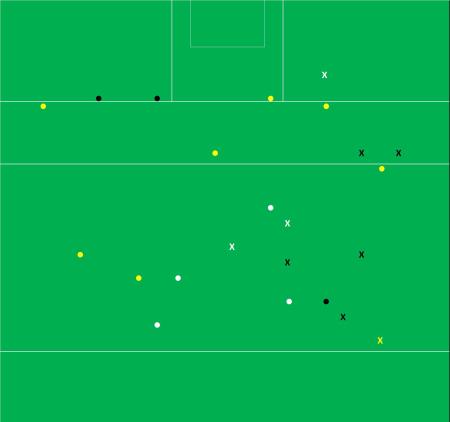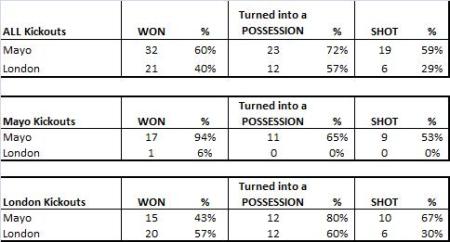For those new to the blog, or who haven’t been here for a while, please find a refresher on the definitions and how the numbers are compiled here
| Team | Possessions | Attacks | Shots | Scores | Exp Pts |
| Mayo | 40 | 35 | 27 | 0 – 12 | 14.69 |
| Galway | 41 | 34 | 23 | 1 – 12 | 12.33 |
Overview
81 possessions in total is very low. In the 31 Championship games charted in 2017 only one – Carlow v Dublin at 79 possessions – came in lower whilst there were 106 total possessions in the 2016 meeting of these teams and 113 in 2017. The low possession total was very much aligned to the “new look” Galway which emerged during this year’s league campaign. In the five games involving Galway shown live on TV the possession totals were 77, 77, 78, 78 and 84.
Focusing on Mayo the positive is that they produced four more shots than Galway in a game where they, for various reasons, managed to get just over one full game from the two O’Connor brothers, Lee Keegan & Tom Parsons combined as well as playing with 14 men for more than half the game. The downside? Old failings, that have haunted them at various ports in this journey, are still evident. Poor conversion rates. Frees from the right. Ill-discipline.
Galway? Once again they won a game by hitting their marks. Progression from the league was maintained by continuing to condense games and converting at an above average rate. They may be concerned at just how long it took them to break down a team playing with 14 but somehow I doubt it. They played *their* game and won. Move on.
When Mayo had the ball
Overall Mayo were able to get shots off at a better rate than Galway (27 shots from 40 possessions as against 23 from 41 for Galway) however the execution was very poor. Perhaps surprisingly the majority of the damage was done *before* the sending off. Up until D O’Connor’s red card Mayo had attempted 12 shots scoring 0 – 05 (42%). Three of these points were from frees leaving their point attempts from play at a very poor 25% (0 – 02 from 8; Expt Pts of -1.971). When they went down to 14 their overall Conversion Rates improved to 46% (0 – 06 from 13; Expt Pts of +0.240). This improvement only dragged them up to average however and couldn’t “fix” the poor start.
This poor shooting is nothing new. Galway have proven to be kryptonite to Mayo’s forwards. In 2016 and 2017 combined Mayo were a very poor 28% (0 – 11 from 38) on point attempts from play. Here they were 38% (0 – 09 from 21).
Below is the 2018 point attempts (in yellow) overlaid on the 2016 and 2017 shots (black). A couple of things are stand out. Lessons were learned in terms of shot location in that unlike the previous two years there were no wild shots this year from out on the wings (possibly aided by Galway’s inverted umbrella defence around the D allowing Mayo to get closer) however on the flipside Mayo were unable to get inside the cover during this year’s encounter.
From a shooting perspective no one stood out. Kevin McLoughlin converted his two shots from play but also missed two readily convertible frees from the right (he also turned down a difficult third free from the right wing on the 20m line).
A O’Shea had a quietly efficient game. He ended up with five primary assists for shots on goal – the next highest on either team was three.
The lack of offensive depth on the bench is a stick regularly used to beat Mayo with. They were already stretched given the above noted absences but again the last ~30 minutes were effectively left to the stalwarts. Those involved in the shots, from when Parsons went off and C O’Connor came on, were
Shots – A Moran x3, C O’Connor x2, K McLoughlin, C Boyle & J Durcan x1
Assists – K Higgins x3, A O’Shea & C O’Connor x2
Stretch it out to the 2nd last pass – where it mattered in the lead up to the shot – the players involved were C O’Connor x3, A O’Shea & J Doherty x.
Tough I know given that C O’Connor was a sub, and the defensive realignments allowed Higgins to move forward, but you want to see Loftus & Doherty more involved in this period when they were on the pitch. S Coen (though he won the free at the death) and P Durcan as well. One shot from J Durcan was the sum attacking involvement of the 2nd rank in that last 30 minutes.
When Galway had the ball
As intimated earlier the shape of the game was played out to Galway’s league template; low possessions high conversion rates.
The Conversion Rates, and high Expt Pts (+2.67), were aided greatly by McHugh’s two very good free kicks and them converting the only goal chance in the game. McHugh’s two frees were on the edge of the normal free taking range, or just outside it, and the conversion of both saw him bring his excellent league form (90%; 0 – 19 from 21 with an Expt Pts of +2.42) through to the Championship.
Galway’s point attempts were essentially average (47%; 0 – 09 from 19 Expt Pts of -0.416) with Comer (0 – 02 from 3) and Duggan (0 – 02 from 2) standing out.
Galway, unlike Mayo, managed to get a great kick from their bench. In the same period as noted above they got shots from P Cooke x2, S Kelly, E Brannigan and T Flynn after he came back on. Another player who stood out was Ian Burke. In his ~20 minutes on the pitch he was central to 1 – 02 of Galway’s late scoring providing a primary assist on three shots and was also the link man for Heaney’s goal.
Kickouts
Despite the intensity of the game, the nature of the teams, the pre-game talk about David Clarke’s kickouts, Galway’s league “form” in terms of eschewing short kickouts, this being the first televised Championship game under the new kickout rule – the kickouts were quite boring! The kickout team won 83% of the game’s kickouts. 62% (26 of 42) of kickouts were short with only one being won by the opposition.
The red card played into this. Nine of Galway’s eleven second half kickouts went short to the left as Mayo dropped off. Looking at Mayo’s kickout chart it is perhaps surprising that Galway didn’t make hay on Mayo’s 2nd half kickouts. First half (black on the chart) were pulled mainly to Clarke’s left – Galway could easily have pushed up hard against 14 in the second half but didn’t manage to in any effective manner.























